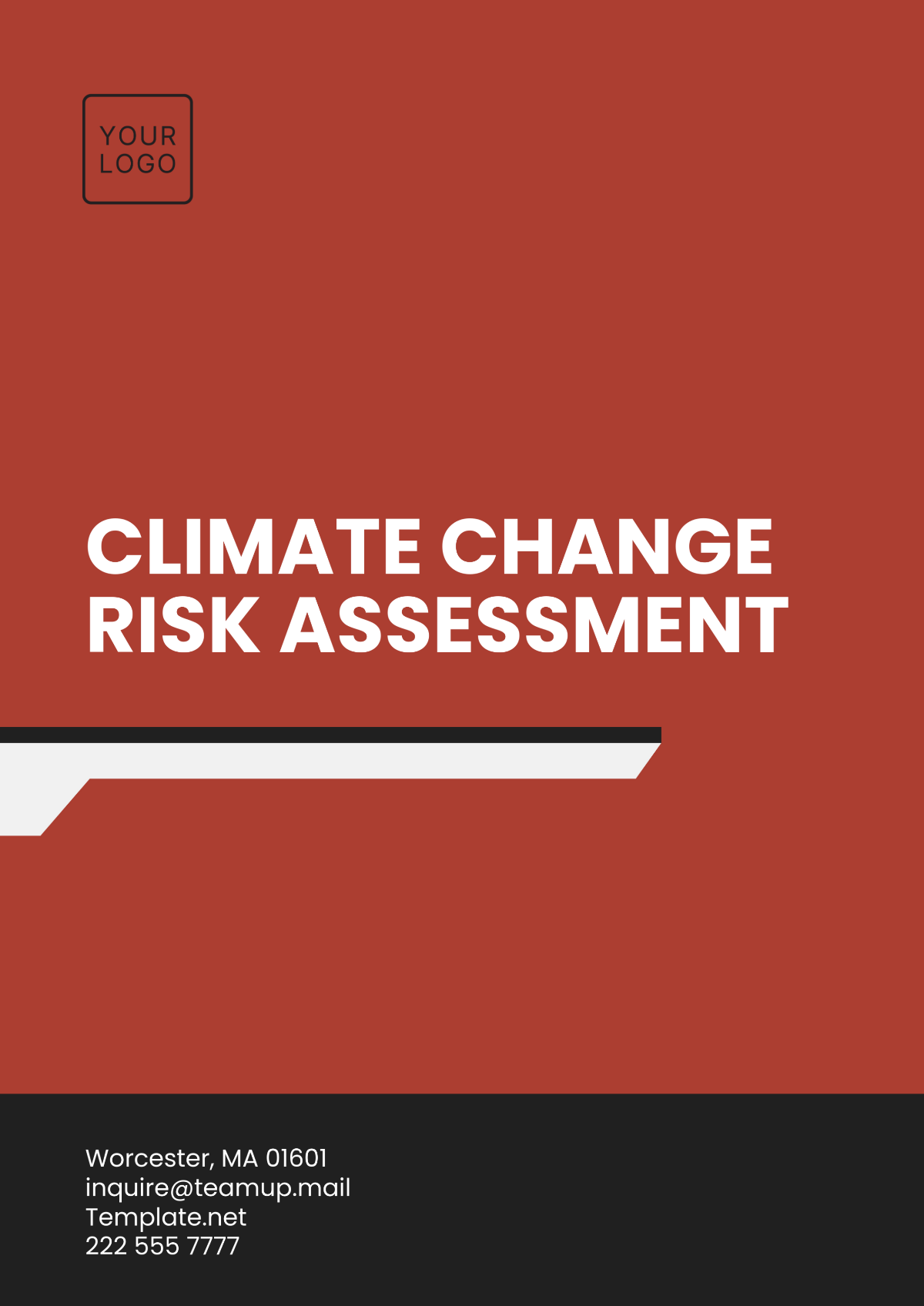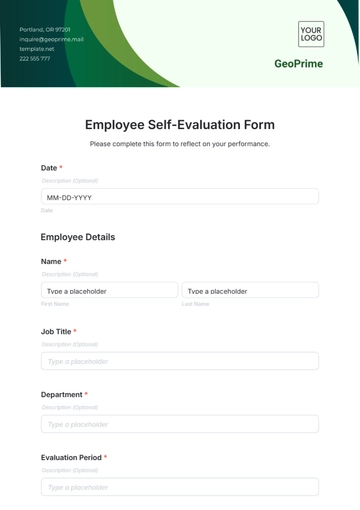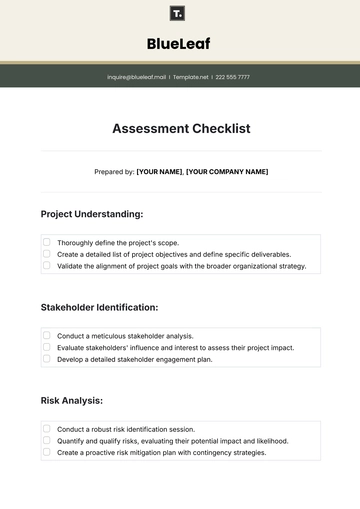Climate Change Risk Assessment
1. Introduction
This Climate Change Risk Assessment is designed to evaluate the potential risks associated with climate change, including extreme weather events, rising sea levels, and other environmental changes that may affect the organization's operations and long-term viability. The assessment helps the organization improve resilience and adopt sustainability practices to mitigate these risks.
2. Organization Overview
Organization Name: Coastal Industries Corp.
Sector/Industry: Manufacturing & Distribution
Assessment Period: 2090-2099
Location(s): Coastal Region, North American East Coast
Assessment Team: Environmental Sustainability Team, Risk Management, Operations, IT & Data Analysis Teams
3. Objective of the Assessment
The goal is to assess climate-related risks and opportunities, specifically focusing on the effects of climate change from 2090 to 2100. The outcomes will guide the development of adaptation and mitigation strategies, ensuring that the organization remains resilient and compliant with evolving regulations.
4. Scope of the Assessment
Climate Risks Considered: Rising sea levels, severe storms, flooding, heatwaves, droughts, regulatory changes
Geographical Focus: Manufacturing plant located in the coastal city, warehouse facility near the shoreline, and supply chain operations across the region
Time Horizon: 2090-2100 (Long-term)
5. Climate Change Risks Identification
Risk Category | Specific Risks | Risk Description |
|---|
Physical Risks | Sea-level rise, Storm Surges, Extreme Heatwaves, Flooding | Risks due to extreme weather events such as hurricanes, tidal flooding, and increased heatwaves, directly impact infrastructure and operational continuity. |
Regulatory Risks | Carbon Pricing, Emissions Reduction Targets, Water Usage Regulations | Evolving climate policies including carbon taxes, restrictions on water usage, and stricter emissions standards will affect cost structures and operational practices. |
Reputational Risks | Public Perception, Environmental Accountability | Negative public perception if the company fails to mitigate its environmental footprint or if it becomes a target for environmental advocacy groups. |
Operational Risks | Disrupted Supply Chains, Infrastructure Damage, Resource Shortages | Increased frequency of severe weather events could disrupt supply chains and damage critical infrastructure such as warehouses and production facilities. |
Market Risks | Demand Shifts, Price Volatility, Supply Chain Shortages | Changing consumer preferences, market price fluctuations due to climate-related scarcity of raw materials, and increased competition for resources. |
6. Risk Assessment and Analysis
Risk Evaluation Matrix
Risk | Likelihood (1-5) | Impact (1-5) | Risk Level (Likelihood x Impact) | Priority |
|---|
Sea-Level Rise | 5 | 5 | 25 | High |
Storm Surges | 4 | 5 | 20 | High |
Extreme Heatwaves | 5 | 4 | 20 | High |
Flooding | 5 | 4 | 20 | High |
Carbon Pricing | 4 | 3 | 12 | Medium |
Water Usage Regulations | 3 | 4 | 12 | Medium |
Resource Shortages | 3 | 3 | 9 | Medium |
Likelihood (1 = Unlikely, 5 = Very Likely)
Impact (1 = Minimal, 5 = Severe)
Risk Level = Likelihood x Impact (Total: 1-25)
Priority: Rank the risk based on the total score (High, Medium, Low).
7. Vulnerability Assessment
Identify the key vulnerabilities within the organization that could be exacerbated by climate change risks.
Vulnerable Assets:
Coastal Manufacturing Plant
Warehouse near the shoreline
Critical machinery and infrastructure exposed to extreme heat
Vulnerable Operations:
Manufacturing processes reliant on uninterrupted electricity and water supply
Logistic operations affected by supply chain disruptions
IT systems vulnerable to extreme heat or flooding
Vulnerable Workforce:
Employees working in facilities located in flood-prone areas
Office staff exposed to heat stress or working conditions in high temperatures
Field staff in logistics operations vulnerable to extreme weather conditions
8. Mitigation and Adaptation Strategies
A. Mitigation Strategies
Risk | Mitigation Action | Timeline | Responsible Party | Resources Needed |
|---|
Sea-Level Rise | Relocate key operations inland, enhance flood-barriers | Short-term (2090-2095) | Facilities Manager | Real estate analysis, construction budget |
Storm Surges | Strengthen infrastructure (buildings, roads) to withstand surges | Medium-term (2095-2098) | Operations Team | Structural engineers, storm-resistant materials |
Extreme Heatwaves | Install advanced cooling systems in critical workspaces | Short-term (2090-2093) | IT & Operations Teams | Cooling technology, installation budget |
Flooding | Elevate warehouses and reinforce foundations | Medium-term (2095-2098) | Risk Management Team | Engineering design, construction materials |
Carbon Pricing | Invest in carbon-neutral technologies and increase renewable energy use | Long-term (2095-2100) | Sustainability Team | Renewable energy investments, green technology |
Water Usage Regulations | Implement water recycling and conservation technologies | Short-term (2090-2095) | Sustainability Team | Water-saving systems, budget for technology |
Resource Shortages | Diversify the supply chain, invest in alternative materials and suppliers | Medium-term (2095-2098) | Supply Chain Manager | Supply chain analysis, vendor contracts |
B. Adaptation Strategies
Risk | Adaptation Action | Timeline | Responsible Party | Resources Needed |
|---|
Drought | Implement water-efficient systems and drought-resistant materials | Short-term (2090-2093) | Operations & Facilities | Water-efficient tools, training |
Storms | Update disaster recovery plans, build storm-resistant facilities | Medium-term (2095-2098) | Risk Management Team | Emergency plans, storm-resistant equipment |
Sea-Level Rise | Implement managed retreat for flood-prone areas and relocate operations | Long-term (2095-2100) | Executive Team | Real estate plans, financial planning |
9. Financial Implications
Risk | Estimated Cost of Mitigation/Adaptation | Budget Allocation | Funding Source |
|---|
Sea-Level Rise | $20 million | $20 million | Internal funds, Insurance |
Storm Surges | $15 million | $15 million | Internal funds, Insurance |
Extreme Heatwaves | $5 million | $5 million | Sustainability budget |
Flooding | $10 million | $10 million | External grants, Internal funds |
Carbon Pricing | $30 million | $30 million | Revenue from operations, green bonds |
Water Usage Regulations | $3 million | $3 million | Internal funds |
Resource Shortages | $8 million | $8 million | Business Continuity Funds |
10. Monitoring and Review
Monitoring Frequency: Annually
Key Performance Indicators (KPIs):
Reduction in carbon footprint
Reduced incidents of supply chain disruptions
Operational resilience during extreme weather events
Compliance with regulatory requirements (e.g., emissions targets)
Review Process: Quarterly team reviews, updated risk reports
Adjustments: Triggered by new climate data, regulatory changes, or unforeseen disruptions in operations.
11. Conclusion
The Climate Change Risk Assessment highlights several critical risks related to extreme weather events, rising sea levels, and regulatory changes, with severe implications for the organization’s operations, reputation, and financial stability. The proposed mitigation and adaptation strategies, particularly around relocating vulnerable assets, reinforcing infrastructure, and shifting to renewable energy sources, are essential to ensuring long-term sustainability and resilience. Immediate attention is required to implement early-stage mitigation actions, including investing in storm-resistant infrastructure and reducing water usage.
Assessment Templates @ Template.net






























